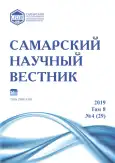Влияние экологических условий на эффективность вегетативного размножения сортов сирени в Южно-Уральском ботаническом саду (г. Уфа)
- Авторы: Полякова Н.В.1
-
Учреждения:
- Южно-Уральский ботанический сад-институт Уфимского федерального исследовательского центра РАН
- Выпуск: Том 8, № 4 (2019)
- Страницы: 74-77
- Раздел: Общая биология
- URL: https://journals.rcsi.science/2309-4370/article/view/34466
- DOI: https://doi.org/10.17816/snv201984112
- ID: 34466
Цитировать
Полный текст
Аннотация
В работе представлены результаты многолетнего (2001–2018 гг.) изучения способов вегетативного размножения сортов рода Syringa L. на базе Южно-Уральского ботанического сада-института УФИЦ РАН. Цель исследования – определение наиболее эффективных и доступных способов размножения сортов сирени в климатических условиях Южного Урала, а также выявление экологических факторов, влияющих на эффективность вегетативного размножения. На протяжении всего периода исследований изучались такие способы вегетативного размножения сортов сирени, как весенние прививки, летняя окулировка, размножение воздушными отводками, зеленое черенкование. В результате исследований выявлено, что максимальный выход корнесобственного посадочного материала получается при размножении сортов зелеными черенками с применением в качестве субстрата песка или смеси песка с перлитом. В условиях Предуралья парники в открытом грунте для укоренения черенков сирени практически непригодны, т.к. укорененные черенки гибнут в них зимой или ранней весной. Поэтому в климатических условиях Башкортостана укоренение черенков сирени желательно проводить в холодной теплице. С помощью весенней прививки можно омолодить старые привитые экземпляры, а летнюю окулировку можно использовать при условии обеспечения привитым растениям комфортной зимовки, поскольку ранние заморозки, характерные для Башкирского Предуралья, приводят к гибели прижившихся и еще не одревесневших побегов. Метод воздушных отводков можно считать приемлемым и перспективным для вегетативного размножения сортов сирени.
Ключевые слова
Полный текст
Открыть статью на сайте журналаОб авторах
Наталья Викторовна Полякова
Южно-Уральский ботанический сад-институт Уфимского федерального исследовательского центра РАН
Автор, ответственный за переписку.
Email: barhan93@yandex.ru
кандидат биологических наук, ведущий научный сотрудник лаборатории дендрологии, лесной селекции и интродукции древесных растений
Россия, УфаСписок литературы
- Мурзабулатова Ф.К., Полякова Н.В. Интродукция малораспространенных декоративных красивоцветущих кустарников в Башкирском Предуралье // Растительный мир Азиатской России. 2016. № 2 (22). С. 73–83.
- Мурзабулатова Ф.К., Полякова Н.В., Никитина Л.С., Путенихин В.П., Шигапов З.Х. Красивоцветущие и декоративно-лиственные кустарники (Фрутицетум, Сирингарий и некоторые другие коллекционные участки Уфимского ботанического сада). Уфа: Мир печати, 2018. 152 с.
- Мурзабулатова Ф.К., Полякова Н.В. Малораспространенные декоративно-лиственные кустарники коллекции Уфимского ботанического сада [Электронный ресурс] // Живые и биокосные системы. 2015. № 13. – http://www.jbks.ru/archive/issue-13/article-5.
- Молканова О.И. Биотехнологические методы устойчивого воспроизводства и сохранения генофонда рода Syringa L. // International Syringa 2018: мат-лы междунар. науч.-практ. конф. Москва, Санкт-Петербург, 21–27 мая 2018 г. / отв. ред. В.В. Чуб. М.: ООО «Клуб печати», 2018. С. 202–204.
- Шипунова А.А. Ускоренное размножение сортов сирени обыкновенной // International Syringa 2018: мат-лы междунар. науч.-практ. конф. Москва, Санкт-Петербург, 21–27 мая 2018 г. / отв. ред. В.В. Чуб. М.: ООО «Клуб печати», 2018. С. 208–210.
- Окунева И.Б. Сирень: Уход, обрезка, размножение, сорта. М.: Фитон XXI, 2019. 288 с.
- Зыкова В.К., Кравченко И.Н. Вегетативное размножение сортов сирени в условиях южного берега Крыма // Сборник научных трудов Государственного Никитского ботанического сада. 2017. Т. 145. С. 68–270.
- Лях Е.М. Изучение сортов Syringa vulgaris из коллекции Центрального Сибирского ботанического сада СО РАН // Растительный мир Азиатской России. 2015. № 3 (19). С. 99–103.
- Полякова Т.В. Мастер сиреневой кисти. Памяти Леонида Колесникова. М.: Пента, 2018. 160 с.
- Сахарова А.С. Итоги интродукции и селекции сирени в Ботаническом саду за 1958–1972 гг. // Интродукция и селекция декоративных растений в Башкирии. Уфа, 1978. С. 5–35.
- Полякова Н.В. Интегральная оценка перспективности видов рода Syringa L. в коллекции Уфимского ботанического сада // Известия Уфимского научного центра РАН. 2016. № 3. С. 70–73.
- Полякова Н.В., Мурзабулатова Ф.К. Ассортимент декоративных кустарников для создания сада непрерывного цветения в условиях Башкирского Предуралья // Аграрная Россия. 2017. № 2. С. 10–17.
- Путенихин В.П., Путенихина К.В., Шигапов З.Х. Кедр сибирский в Башкирском Предуралье и на Южном Урале: биологические и лесоводственные особенности при интродукции. Уфа: Башк. энцикл., 2017. 248 с.
- Ilczuk A., Jagiello-Kubiec K. The effect of plant growth regulators and sucrose on the micropropagation of common lilac (Syringa vulgaris L.) // Horticulture and Landscape Architecture. 2015. № 36. P. 3–12.
- Nemadodzi L.E., Prinsloo G. Factors affecting the propagation, re-growth and re-establishment of Burkea africana (Wild syringa) seedlings to reach reproductive stage // South African Journal of Botany. 2016. № 103. P. 338–339.
- Craig J. Propagation of trees and shrubs from cuttings // Bulletin: 2017. Vol. 1, № 4, Article 5. Available at: http://lib.dr.iastate.edu/bulletin/vol1/iss4/5.
- Liu C., Liu H., Yang B., Yang L., Zhang P. Shoot multiplication of Syringa reticulata var. mandshurica from in vitro cultured seedlings // Journal of Forestry Research. 2017. Vol. 28, is. 1. P. 41–46.
- Peterson B.J., Burnett S.E., Sanchez O. Submist is effective for propagation of Korean lilac and inkberry by stem cuttings // Hort Technology. 2018. Vol. 28, is. 3. P. 378–381.
- Колесников Л.А. Сирень. М.: Московский рабочий, 1952. 52 с.
- Путенихин В.П. Дендрология с основами декоративного садоводства. Ч. I. Уфа: РИО БашГУ, 2006. 164 с.
Дополнительные файлы






